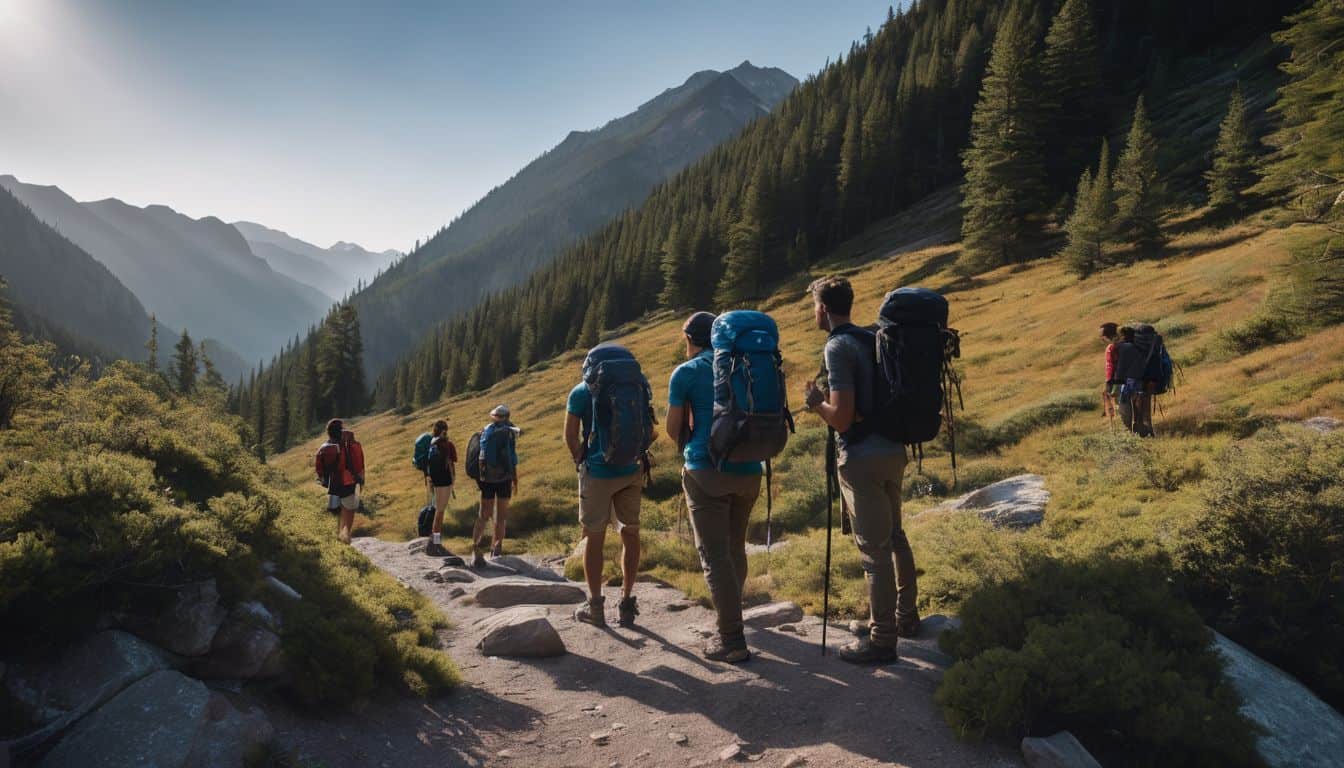As someone who has the hiking bug, I understand what it feels like to be a little rusty, yet have an exciting trek ahead. Hiking isn’t just about reaching that peak; maintaining your fitness is a crucial element which can help minimize those pesky injuries.
In this post, you’ll discover 13 trusty tips specifically created for hiking training and enhancing your overall fitness level. These will equip you with the confidence needed to tackle any trail head-on.
Are we all set? Get ready, let’s embark on this journey together!
Key Takeaways
- Establish a training schedule for hiking that includes cardio workouts, strength exercises, flexibility training, and setting goals.
- Incorporate specific exercises such as jump squats, hip roll exercises, step – up exercises, heel down exercises, squat curl overhead press exercises, and bridge with hamstring exercises to strengthen the muscles necessary for hiking.
- Get the right exercise equipment like dumbbells, resistance bands, a yoga mat, and cardio machines to enhance your hiking training at home.
- Focus on cardiovascular fitness by doing activities like brisk walking or jogging to increase stamina for long hikes.
- Strengthen your legs through goblet squats and single – leg exercises.
- Strengthen your back with rows and lat pulldowns to prevent injuries while hiking.
- Don’t neglect core training with planks and sit-ups to improve balance and stability on the trails.
- Maintain a balanced diet and workout plan that includes both strength training and cardio workouts to build endurance.
- Practice hikes are essential in building endurance, familiarizing yourself with different terrains, testing equipment/footwear before longer hikes
- Mental preparation is crucial for overcoming fears or doubts when embarking on challenging hikes.
- Dedicate time and effort into a hiking-specific training program that incorporates strength-building exercises like lunges and squats along with cardio workouts.
- Try running or walking on sand to strengthen leg muscles important for stability on uneven terrain during hikes.
Basics of Hiking Training
In order to improve your hiking skills and fitness, it is important to establish a training schedule that incorporates specific exercises for hiking.
Training schedule for hiking
I have a great plan to help us get ready for hiking. Before we go on a long hike, we need to train for eight weeks. This is our training schedule:
- We start with cardio workouts. These can be anything that gets the heart beating fast.
- We also do strength exercises. These help us carry heavy things like a backpack or even kids!
- We don’t forget about flexibility. Bending and stretching are both important for hikers.
- Next, we set a goal for how far and high we want to hike in the end.
- Now, it’s time to start working towards that goal.
- Each week, we walk a little further and higher than before.
- By the last week of training, we reach our goal.
Training exercises for hiking
Hiking is a fun way to keep fit but needs some work upfront. Here are some top exercises to help you get ready:
- Jump Squats: This exercise strengthens your leg muscles.
- Hip Roll Exercises: They assist you in moving with ease on uneven surfaces.
- Step-Up Exercises: These help in climbing uphill while hiking.
- Heel Down Exercises: They increase strength for navigating downhill paths.
- Squat Curl Overhead Press Exercises: Aimed at full-body workout, this is good for general endurance.
- Bridge with Hamstring Exercises: It offers core and lower body strength.
Shopping for exercise equipment
Getting the right exercise gear boosts your hiking training. You can set up a small gym at home. A treadmill or an exercise bike helps with cardio workouts. Dumbbells and resistance bands aid in strength training.
A yoga mat is good for doing bodyweight exercises like squats and lunges. Even without a full gym, basic equipment makes a big difference in fitness growth for hiking!
Comprehensive Guide on Hiking Training and Fitness

Are you ready to take your hiking to the next level? In this comprehensive guide, I will share with you some valuable tips and exercises that will help improve your hiking training and fitness.
It’s important to have a well-rounded training program if you want to be prepared for those challenging trails. Incorporating strength training exercises into your workout plan is crucial for building endurance, stability, and preventing injuries on the trail.
Don’t forget about aerobic fitness too! Activities like swimming, cycling, or exercise classes can help improve your overall trail fitness. And if you’re planning on doing long day hikes with a weighted pack, increasing your cardio activity is key.
Remember that hiking not only builds muscle but also provides cognitive benefits and releases happiness hormones. So lace up those boots and get ready to conquer the trails!
How to Prepare for a Hike: 8 Fitness Tips for the 50+ Explorer
If you’re over 50 and looking to prepare for a hike, these fitness tips will help you get in shape and build confidence on the trails.
Give yourself time to prepare
When it comes to preparing for a hike, giving yourself enough time is crucial. It’s recommended to start getting physically and mentally ready at least six months before your hiking challenge.
This will give you ample time to gradually increase your fitness level and build up endurance. Creating a training schedule about 12 weeks before the hike can also help you track your progress and stay on track with your goals.
If you’re a beginner hiker, you can benefit from following training programs that last between 6 to 8 weeks. Remember, proper preparation is key for a successful and enjoyable hiking experience!
Focus on your cardiovascular fitness
To improve your hiking performance, it’s important to focus on your cardiovascular fitness. Cardiovascular exercises, like brisk walking or jogging, can help strengthen your heart and lungs, increasing your stamina for those long hikes.
Even if you can’t go outdoors or visit a gym, you can still do cardio exercises at home. Activities like jumping jacks or running in place are great options. Building up your endurance through regular cardio workouts will make it easier for you to tackle hills and mountains during your hikes.
So don’t forget to include some cardio training in your hiking preparation routine!
Focus on leg strength
Leg strength is crucial for hikers, especially if you’re 50 years old or older. Strong legs will help you tackle difficult terrains and prevent injuries. To improve your leg strength, try doing exercises like goblet squats, which target major leg muscles such as the quads and glutes.
Single-leg exercises are also beneficial because they enhance stability and balance. Back squats are an excellent way to increase overall leg strength for hiking. Remember to focus on maintaining proper hiking posture as well, as this will make your hiking experience more enjoyable and less tiring.
Strengthen your back
One important tip for preparing for a hike is to strengthen your back muscles. Strengthening exercises can help you improve your overall fitness and reduce the risk of injury while hiking.
Some great exercises to target your back muscles include rows, deadlifts, and lat pulldowns. You can also do exercises with a backpack on to make them more challenging. Remember to start with lighter weights and gradually increase as you get stronger.
By focusing on strengthening your back, you’ll be better equipped to handle the demands of hiking and enjoy your outdoor adventures even more!
Don’t neglect your core
Having a strong core is crucial for hikers. It’s not just about looking good, it’s about balance and stability on the trails. When you neglect your core, you can end up with imbalances that can lead to injuries while hiking.
That’s why it’s important to focus on building your core strength before hitting the trails.
A strong core stabilizes your spine and allows for efficient movement during hikes. It also helps protect your lower back from pain and discomfort. So don’t overlook this important aspect of training.

Keep it balanced
Balance is key when it comes to preparing for a hike. Not only should you focus on physical fitness, but also on maintaining a balanced and nutritious diet. By fueling your body with the right nutrients, you can optimize your performance during training and while on the trail.
Additionally, having a balanced workout plan that includes both strength training and cardiovascular exercises will help you build endurance and prevent injuries. Remember to listen to your body and give yourself enough time to rest and recover between workouts.
With a balanced approach, you’ll be ready for any hiking adventure that comes your way!
Don’t forget the practice hikes
Practice hikes are a crucial part of your hiking training. They help you build endurance, strengthen your muscles, and get familiar with different terrains. Start with shorter hikes and gradually increase the distance and difficulty.
This will prepare your body for longer treks and challenging trails. Remember to wear proper hiking gear, stay hydrated, and listen to your body’s cues during practice hikes. It’s also a great opportunity to test out any new equipment or footwear before embarking on longer hikes.
So don’t forget to include regular practice hikes in your training routine for a safe and enjoyable hiking experience.
Mental preparation is also important
When it comes to hiking, mental preparation is just as important as physical training. As someone who is 50 years old or above, it’s crucial to overcome any fears or doubts you may have before heading out on a challenging hike.
By setting realistic expectations and having a clear purpose in mind, you can build the right mindset for a successful outdoor adventure. Mental preparation goes beyond physical conditioning – it involves developing mental focus, resilience, and confidence.
So remember to train your mind along with your body to fully enjoy the experience of hiking.
How to Train for Hiking
Train for hiking by dedicating time and effort to a hiking-specific training program. Try running or walking on sand to increase range of motion. Incorporate exercises such as squats, lunges, and push-ups for strength training.
Focus on cardio fitness with activities like step-ups. Consider setting up a home gym for convenience. Read more to discover additional tips and techniques for improving your hiking training and fitness.
Dedicate time and effort into a hiking-specific training program
To improve your hiking skills, it’s important to dedicate time and effort into a training program that focuses specifically on hiking. This means incorporating exercises that will help build the strength, endurance, and flexibility needed for hiking.
You can try running or walking on sand to simulate the uneven terrain you may encounter on the trails. Increasing your range of motion through stretching exercises will also be beneficial.
Additionally, exercises such as squats, lunges, and push-ups will help strengthen your muscles for those uphill climbs. Remember to include cardio workouts to improve your cardiovascular fitness.
Try running or walking on sand
When it comes to training for hiking, one beneficial strategy is to try running or walking on sand. Sand hiking can help build the muscles that protect your knees and prevent sprains while hiking.
Even if you don’t have easy access to sand, training for sand hiking can still be useful. Walking in sand helps strengthen key leg and ankle muscles, which are important for stability on uneven terrain.
So whether you’re at the beach or not, give sand running or walking a try to build strength and prevent injuries while hiking.
Increase range of motion
To get ready for hiking, it’s important to increase your range of motion. This means being able to move your body freely and comfortably. Good range of motion helps prevent injuries and makes it easier to navigate different terrains on the trail.
To improve your flexibility, you can do stretching exercises that target all parts of your body, such as arms, legs, and hips. Yoga or Pilates can also be beneficial in enhancing flexibility.
By regularly working on increasing your range of motion, you’ll feel more fluid and agile while hiking.
Exercises such as squats, lunges, and push-ups
Exercises like squats, lunges, and push-ups are great for preparing for hiking. They help build strength in your lower body muscles, which is important for hiking. Here are some exercises you can do:
- Squats: Stand with your feet shoulder-width apart and lower yourself as if sitting back into a chair. Push through your heels to stand back up.
- Lunges: Take a step forward with one leg and lower your body until both knees are at 90-degree angles. Push through your front heel to return to the starting position.
- Push-ups: Start in a plank position with your hands slightly wider than shoulder-width apart. Lower your body by bending at the elbows, then push back up.
Cardio fitness
Cardio fitness is crucial for improving your hiking abilities. It’s all about training your heart and lungs to work efficiently during physical activity. When you focus on aerobic exercises, like walking or jogging, it helps strengthen your cardiovascular system.
By getting your heart rate up in the right zones (zones 1 and 2), you can enhance your endurance and stamina for hiking. It’s not just about aerobic exercise though; anaerobic exercises also play a role in improving cardiovascular health.
So, make sure to include a mix of both types of exercises in your hiking training plan. Whether you follow a 6-week or 12-week program, dedicating time to cardio fitness will greatly benefit your overall hiking performance.
Step-ups
Step-ups are a great exercise for hikers because they help build strength and endurance in the glutes and quads. By mimicking the movements performed while ascending hiking trails, step-ups specifically target the muscles needed for uphill hiking.
Including bodyweight exercises like step-ups and lunges in your workout plan can prepare your legs for those challenging inclines on the trail. So, if you want to improve your hiking performance, don’t forget to incorporate step-ups into your training routine!
Setting up a home gym
To get in shape for hiking, it’s a great idea to set up a home gym. Here are some tips on how to do it:
- Find a dedicated space in your home where you can set up your gym equipment.
- Choose equipment that will help improve your strength and cardiovascular fitness. This can include a treadmill, elliptical machine, or weightlifting equipment.
- Make sure you have enough room for the equipment and that it is properly installed and set up according to the manufacturer’s instructions.
- Stock up on any necessary accessories such as weights, resistance bands, or yoga mats.
- Create a workout schedule that fits into your daily routine and stick to it. Consistency is key.
- Start with shorter workouts and gradually increase the intensity and duration as your fitness level improves.
- Keep track of your progress by recording your workouts and monitoring your improvement over time.
Fitness Tips for Steep & Rocky Trails
When hiking on steep and rocky trails, it is important to use trekking poles for stability and support.
Hiking with trekking poles
Using trekking poles while hiking can greatly improve your balance, especially when navigating steep and rocky trails. They provide stability and support, making it easier to cross streams with a heavy backpack.
Not only do trekking poles enhance your workout by allowing for a more intense exercise session, but they also reduce strain on your knees. In fact, studies have shown that using trekking poles can take up to 25% of the strain off your knees while hiking.
Additionally, they give your arms a good workout and help prevent hand swelling as you gain elevation during your hike. So don’t forget to bring along your trekking poles for an even better hiking experience!
Taking your time on strenuous trails
When tackling strenuous trails, it’s important to take your time and go at a pace that feels comfortable for you. Rushing through these types of trails can increase the risk of accidents or injuries.
Instead, listen to your body and adjust your speed accordingly. Give yourself breaks when needed and use them as an opportunity to rest, hydrate, and take in the beautiful surroundings.
By taking your time and being mindful of your physical limits, you can enjoy the challenge of strenuous hiking trails while also staying safe and preventing exhaustion.
Choosing the right shoes
When it comes to choosing the right shoes for hiking, there are a few important things to consider. First, make sure your footwear provides good traction and stability on steep and rocky trails.
This will help prevent slips and falls. Second, think about the terrain you’ll be hiking on and choose shoes that offer appropriate protection. If you’re going on a longer hike or carrying a heavy backpack, consider opting for hiking boots as they provide extra stability.
However, if you prefer lighter footwear, trail-running shoes can also be a great option as long as they feel comfortable and support your body mechanics while walking. Ultimately, it’s all about finding the pair that suits your individual needs and preferences best!
Preparing for a Backpacking Trip
Selecting the right gear and increasing your physical fitness are crucial steps in preparing for a backpacking trip. Discover how to choose the perfect equipment and learn effective training methods to ensure a successful adventure.
Read on to take your hiking skills to new heights!
Selecting the right gear
Choosing the right gear is crucial for a successful hiking trip. Here are some tips to help you select the best gear:
- Assess your current gear: Take a look at all your hiking equipment and determine if any repairs or replacements are needed. It’s important to have gear that is in good condition and functioning properly.
- Check the condition of your gear: Inspect each item carefully to make sure there are no tears, holes, or other damages. If you notice any issues, consider if it can be repaired or if it’s time to invest in a new piece of gear.
- Evaluate your backpack: Your backpack is one of the most important pieces of hiking gear. Make sure it fits well, provides proper back support, and has enough storage space for all your essentials.
- Consider the weather conditions: Depending on where and when you will be hiking, choose gear that is suitable for the weather conditions. This includes clothing, footwear, and accessories like hats and gloves.
- Research reputable brands: Look for outdoor gear brands that are known for their quality and durability. Reading reviews from other hikers can also help you make informed decisions about which products to choose.
- Test out different options: Before committing to buying new gear, try out different options if possible. This can include trying on different hiking boots or testing out different types of tents to see what works best for you.
- Seek expert advice: If you’re unsure about which gear to choose, don’t hesitate to ask for advice from experienced hikers or outdoor enthusiasts. They can provide valuable insights based on their own experiences.
Increasing your physical fitness
To have a successful backpacking trip, it’s important to increase your physical fitness. This will help you endure the long hikes and prevent injuries. Engaging in strength training exercises, such as lunges and squats, will help build muscle strength and improve stamina for those uphill climbs.
Aerobic exercises like running or walking on sand can also improve your endurance. Don’t forget to gradually increase the distance of your hikes to challenge yourself and prepare for longer treks.
Working with a personal trainer who specializes in high altitude hiking can provide valuable guidance and create a personalized workout plan that suits your needs. Remember, improving your physical fitness will make your hiking experience more enjoyable and safe.
Basic 9-week early season training program
I’ve found that following a 9-week early season training program is an excellent way to prepare for a backpacking trip. It provides a way to increase physical fitness gradually while focusing on specific areas important for hiking. Here’s a brief overview of the program in a helpful table format:
PlanIntroduce cardio into your routine, start with 20-minutes per day and gradually increase the durationStart incorporating strength exercises specific to hiking like squats, lunges, and push-upsAdd step-ups to your routine, they’re great for building hiking-specific musclesGradually increase the distance of your hikes; this will help your body adjust to the physical exertionChange your cardio days to long day hikes carrying a pack; ensure the weight is close to what you’ll carry on your trip
| Week |
|---|
| Week 1-2 |
| Week 3-4 |
| Week 5-6 |
| Week 7-8 |
| Week 9 |
Remember, everyone’s fitness level is different, so don’t worry if you need to adjust the schedule to better suit your needs. The most important thing is to keep moving and prepare your body for the challenge of a hiking trip.
Preparing for Mountain Hiking
Assess your past and current level of fitness and follow a six-month training program to prepare for the challenges of mountain hiking.
Assessing past and current level of fitness
Before embarking on a hiking training regimen, it is essential to assess your current fitness level. Gauging your previous and current level of fitness is vital while preparing for mountain hiking.
Determining past and present fitness levels is imperative for mountain hiking preparations. Hiking demands physical strength, balance, and overall fitness. Sedentary lifestyles are linked to negative health outcomes and increased mortality risk.
So, before you start a hiking training program, evaluating your existing fitness level will help in planning the right exercises and intensity levels to improve your overall physical condition for the challenges of mountain hiking.
Following a six-month training program
Even as a seasoned hiker, it’s essential to follow a systematic training plan for optimal results. A six-month training program gives me ample time to prepare and helps transform my stamina and strength. Here’s a snapshot of the plan I use.
| Month | Focus | Activity / Exercise |
|---|---|---|
| Month 1 and 2 | Basic Fitness | Cardio workouts such as running, swimming, or cycling. Strength training using bodyweight exercises like push-ups and squats. |
| Month 3 | Cardiovascular Endurance | Long day hikes with a weighted pack, helping increase my cardio fitness. |
| Month 4 | Strength and Power | Power workout sessions focusing on leg and core muscles. These include exercises like lunges, step-ups, and planks. |
| Month 5 | High-Altitude Adaptation | Short hikes at high altitudes with increased load. |
| Month 6 | Overall Fitness and Recovery | Long distance hikes and runs, along with yoga and stretching exercises for recovery and flexibility. |
Remember, a well-rounded six-month training program is about more than just physical preparation. It’s about making sure every part of your body is prepared for the intensity of a challenging hike. So take your time, follow the plan, and respect your body’s limits. The mountains aren’t going anywhere.
High-altitude and low-oxygen preparation
Preparing for high altitude hikes requires special attention to the challenges posed by low oxygen levels. Altitude training can help improve your body’s response to exercise and endurance in these conditions.
It is important to have a proper training program that includes aerobic exercises and strength training to build cardiorespiratory fitness. Additionally, acclimatization techniques such as spending time at higher altitudes prior to the hike can also be beneficial.
Proper hydration and nutrition are crucial, and some hikers may consider using supplements to support their preparation for high altitude conditions. Overall, with careful planning and preparation, you can ensure a safe and enjoyable hiking experience at high altitudes.
Preparing for a Thru-Hike
To prepare for a thru-hike, start with a training program that includes increasing cardio and strength, gradually increasing the distance of your hikes.
Starting with a training program
I believe that starting with a training program is essential when preparing for a hiking adventure. By dedicating time and effort into a hiking-specific training program, you can improve your strength, endurance, and overall fitness level.
Incorporating exercises such as lunges, squats, and push-ups can help fortify your muscles, connective tissue, and bones, improving your movement efficiency on the trails. It’s important to gradually increase the intensity and duration of your workouts to avoid injuries.
Remember to also focus on cardiovascular fitness through activities like running or walking on sand. Having a well-rounded workout plan will greatly benefit you when it comes time for your hike!
Increasing cardio and strength
To improve your hiking fitness and prepare for a thru-hike, it’s important to focus on increasing your cardio and strength. Cardio exercises like running or walking can be done 3-5 times a week to build endurance and stamina.
You can also include activities like biking or swimming for variety. Strength training exercises such as lunges, squats, push-ups, and planks will help strengthen your muscles and improve stability on the trails.
Adding resistance through weights or using a backpack while hiking can provide an extra challenge. By incorporating both cardio and strength training into your routine, you’ll be better equipped to tackle long hikes and challenging terrains with ease.
Gradually increasing the distance of your hikes
To prepare for a thru-hike, it’s important to gradually increase the distance of your hikes. By doing this, you can build up your stamina and endurance over time. Start with shorter hikes and then slowly increase the length as you feel more comfortable.
This will allow your body to adjust and adapt to the demands of long-distance hiking. Remember to listen to your body and not push yourself too hard too quickly. By incrementally extending the distance of your hikes, you’ll be better prepared for the challenges that come with thru-hiking.
So lace up those boots and hit the trails!
The Best Exercises to Get in Shape for Hiking
Lunges, Poor Man’s Leg Curl, Band Walks, and Squats are just a few of the exercises that can help you get in shape for hiking. If you want to learn more about these amazing exercises and how they can improve your fitness for outdoor adventures, keep reading!
Lunges
Lunges are an amazing exercise that can help you get in shape for hiking. They challenge your balance and stability, which is important when you’re trekking on uneven terrain. Lunges also work your leg muscles, helping to strengthen and tone them.
This exercise is especially beneficial for women as it targets the lower body, improving strength and muscle tone. By including lunges in your daily routine, you’ll see long-term benefits for your overall fitness and strength.
They can be a great alternative to squats if you want to focus on building leg strength and stability. So give lunges a try and experience the benefits for yourself!
Poor Man’s Leg Curl
The “Poor Man’s Leg Curl” exercise is a great way to strengthen your legs for hiking. You don’t need fancy equipment – just an elevated bench or platform at home. Lie flat on the floor and scoot your hips towards the bench.
Place your left foot on the bench and lift your right leg using your hamstrings and glutes until your hips are fully extended. This exercise targets those important muscles you’ll be using while hiking.
So, give it a try and get ready to hit the trails with stronger legs!
Band Walks
One of the best exercises to get in shape for hiking is band walks. Band walks are great for strengthening the muscles used while hiking, like the glutes, hips, and thighs. They help improve speed, agility, and endurance, making your hikes easier and more enjoyable.
To do band walks, you’ll need resistance bands that provide added challenge and resistance to your muscles. By incorporating these exercises into your training routine, you can target your lower body muscles and prepare yourself for those challenging hiking trails.
Squats
When it comes to getting in shape for hiking, squats are definitely one of the best exercises you can do. Squats target important leg muscles like your quads and hamstrings, which are essential for hiking uphill and navigating uneven terrain.
By doing squats regularly, you’ll be able to increase your overall leg strength, making those long hikes a lot easier and more enjoyable. If you want to take it a step further, you can try back squats too.
These are especially great for building up your leg strength even more. So don’t forget to include some squats in your training routine if you want to be ready for any hiking adventure!
Conclusion on Hiking Training And Fitness
In conclusion, hiking training and fitness are crucial for improving your strength and endurance on the trails. By following these amazing tips, such as setting up a dedicated workout plan, incorporating strength exercises like lunges and squats, and gradually increasing your cardio fitness, you can prepare yourself for successful hikes.
Remember to listen to your body and give yourself time to improve. So lace up your boots, hit the trails, and enjoy the many physical and mental benefits of hiking!
FAQs on Hiking Training And Fitness
1. How can I improve my hiking fitness?
You can improve your hiking fitness by regularly engaging in cardiovascular exercises like walking, jogging, or cycling, as well as strength training exercises that target your leg muscles and core.
2. Are there any specific exercises I should do to prepare for hiking?
Exercises that can help prepare you for hiking include lunges, squats, step-ups, and planks to strengthen your lower body and core muscles. Additionally, incorporating uphill walking or stair climbing into your routine can simulate the demands of hiking.
3. What equipment do I need for hiking?
Essential equipment for hiking includes sturdy footwear with good traction, appropriate clothing layers based on weather conditions, a backpack to carry essentials like water and snacks, a map or GPS device for navigation, sunscreen and bug repellent.
4. How should I plan my hikes to avoid injury?
To avoid injury while hiking: start with easier trails before progressing to more difficult ones; gradually increase distance and elevation over time; take breaks when needed; listen to your body’s signals of fatigue or discomfort; stay hydrated and nourished during the hike.
5. How long does it take to see improvement in my hiking fitness level?
The time it takes to see improvement in your hiking fitness level varies depending on factors such as current fitness level and consistency of training. However, with regular practice and progressive challenges in both endurance and strength training activities related to hiking (e.g., walking uphill), improvements can be seen within a few weeks or months





Leave a Reply